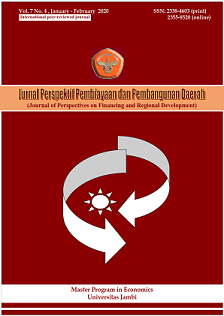Phenomenon and determinant characteristics of NEET (Not in Employment, Education or Training) youth in matrilineal province
DOI:
https://doi.org/10.22437/ppd.v7i4.8690Keywords:
Education, NEET, Training, Unemployment, YouthAbstract
Economic development positions human as an important factor of production. Therefore quality human resources are needed for sustainable development. Indonesia as a country with a large population potential is expected to take advantage of the opportunity through demographic bonuses that will occur in 2020-2030. However, the emergence of NEET (not in employment, education or training) has become a new problem that threatens the success of development. NEET is a measure that includes young people in the age range of 15-24 years old, who are not in employment, education or training. NEET is considered more comprehensive than unemployment because it can see the dynamics and activeness of youth in the labor market. The presence of NEET is inseparable from the determinant characteristics the chances of someone becoming a NEET youth. This study uses Sakernas data for 2017 and 2018 to see the phenomenon and determinant characteristics of NEET status. The result showed NEET youth in West Sumatera was dominated by economically inactive youth. And by using logistic regression analysis, obtained several characteristic that significantly influence the chance of youth’s vulnerability to become a NEET. Youth who live in rural areas have a greater opportunity to become NEET youth, while youth with high level education are even more vulnerable to becoming NEET. Gender does not have a significant effect on determinants of NEET status in areas that adhere to this matrilineal kinship system. Based on the result of this study, the government as the holder of authority is expected to implement policies to reduce the proportion of NEET youth.
Downloads
References
Alfieri, S., Sironi, E., Marta, E., Rosina, A., & Marzana, D. (2015). Young Italian NEETs ( Not in Employment , Education , or Training ) and the Influence of Their Family Background. Europe’s Journal of Psychology, 11(2), 311–322. https://doi.org/10.5964/ejop.v11i2.901
Alimkhanova, D. (2018). Understanding the Rising NEET Phenomenon in Southern Khazakhstan. Central Asia Program Fellows Paper, 206, 1–18.
BPS. (2016). Potret Awal Tujuan Pembangunan Berkelanjutan ( Sustainable Development Goals ) di Indonesia. Jakarta: BPS
BPS. (2012). Analisis Statistik Sosial Bonus Demografi dan Pertumbuhan Ekonomi. Jakarta: BPS
BPS. (2017). Pedoman Pencacah Sakernas Februari 2017. Jakarta: BPS
BPS. (2019). Statistik Indonesia 2019. Jakarta: BPS
Bălan, M. (2016). Economic and Social Consequences Triggered By The Neet Youth. Knowledge Horizons-Economics, 8(2), 80–87.
Becker, G. S. (1994). Human Capital: A Theoritical and Empirical Analysis with Special Reference to Education (Third Edition). Chicago: The University of Chicago Press
Byoung-hoon, L., & Jong-sung, K. (2012). A Causal Analysis of Youth Inactiveness in the Korean Labor Market. Korea Jurnal, 52(4), 139–165. https://doi.org/10.25024/kj.2012.52.4.139
Crismaru, M., Gagauz, O., & Buciuceanu-Vrabie, M. (2017). Inclusion of YouthNot In Employment, Education or Training (NEET Youth). Report of UNDP in the Republic of Moldova. Chisinau.
Drakaki, M., Papadakis, N., Kyridis, A., & Papargyris, A. (2014). Who ’ s The Greek Neet ? Neets ’ Profile in Greece : Parameters , Trends and Common Characteristics of a Heterogeneous Group. International Journal of Humanities and Social Science, 4(6), 240–254.
Elder, S. (2015). What does NEETs Mean and Why is The concept So Easily Misinterpreted ?. Geneva: ILO
Elfindri, Soebiakto, B., Harizal, & Rezki, J. F. (2015). Youth idleness in Indonesia. Asian Social Science, 11(13), 251–259. https://doi.org/10.5539/ass.v11n13p251
Furlong, A. (2006). Not a Very NEET Solution: Representing Problematic Labour Market Transitions Among Early School-Leavers. Work, Employmeny and Society, 20(3), 553–569. https://doi.org/10.1177/0950017006067001
Hakimi, I. D. R P. (1976). Pegangan Bundo Kanduang di Minangkabau. Bandung: CV. Rosda
Hosmer, D.W. & Lemeshow, S. (1989). Applied Logistic Regression. USA: A Wiley-Interscience Publication
International Labour Organization. (2017). Laporan Ketenagakerjaan Indonesia 2017 Memanfaatkan Teknologi untuk Pertumbuhan dan Penciptaan Lapangan Kerja. Kantor Jakarta: ILO
Inui, A., Sano, M., & Hiratsuka, M. (2015). Precarious Youth and Its Social/Political Discourse : Freeters, NEETs, and Unemployed Youth in Japan. (Comparative Studies on NEET, Freeter, and Unemployed Youth in Japan and the UK), 73–100.
Lee, J. (2018). Human Capital Development for Sustained and Innovative Growth - The Korean Experience and its Implication for Late-comers. The 8th International Forum on Economic Development. Bali-Indonesia.
Maryati, S. (2015). Dinamika Pengangguran Terdidik: Tantangan Menuju Bonus Demografi di Indonesia. Journal of Economic and Economic Education, 3(2), 124–136.
Mincer, J. A. (1974). Schooling, Experience and Earnings. New York: National Bureau of Economic Research
Schultz, T. W. (1961). Investment In Human Capital. The American Economic Review, 51(1), 1–17.
Siregar, R. (2017). Sumber Daya Manusia Dalam Pembangunan Nasional. Prosiding Seminar Nasional Tahunan Ilmu Sosial Universitas Negeri Medan, (2), 378–381.
Statistics Canada. (2018). The Transition From School to Work - the NEET ( not in employment , education or training ) Indicator for 15 to 19 Year Olds in Canada. Catallogue no. 81-559-X-No.12. Canada: Statistics Canada
Susanli, Z. B. (2016). Understanding The Neet in Turkey. Eurasian Journal of Economics and Finance, 4(2), 42–57. https://doi.org/10.15604/ejef.2016.04.02.004
Understanding Children’s Work. (2013). NEET Youth Dynamics in Indonesia and Brazil: A Cohort Analysis. Understanding Children's Work (UCW) Programme Working Paper Series. Rome:UCW
Young Women’s Trust. (2014). Literature Review Neets and Gender. London: Young Women's Trust
Downloads
Published
How to Cite
Issue
Section
License
Copyright (c) 2020 Chintia Anggraini, Werry Darta Taifur, Zulkifli N

This work is licensed under a Creative Commons Attribution 4.0 International License.

















